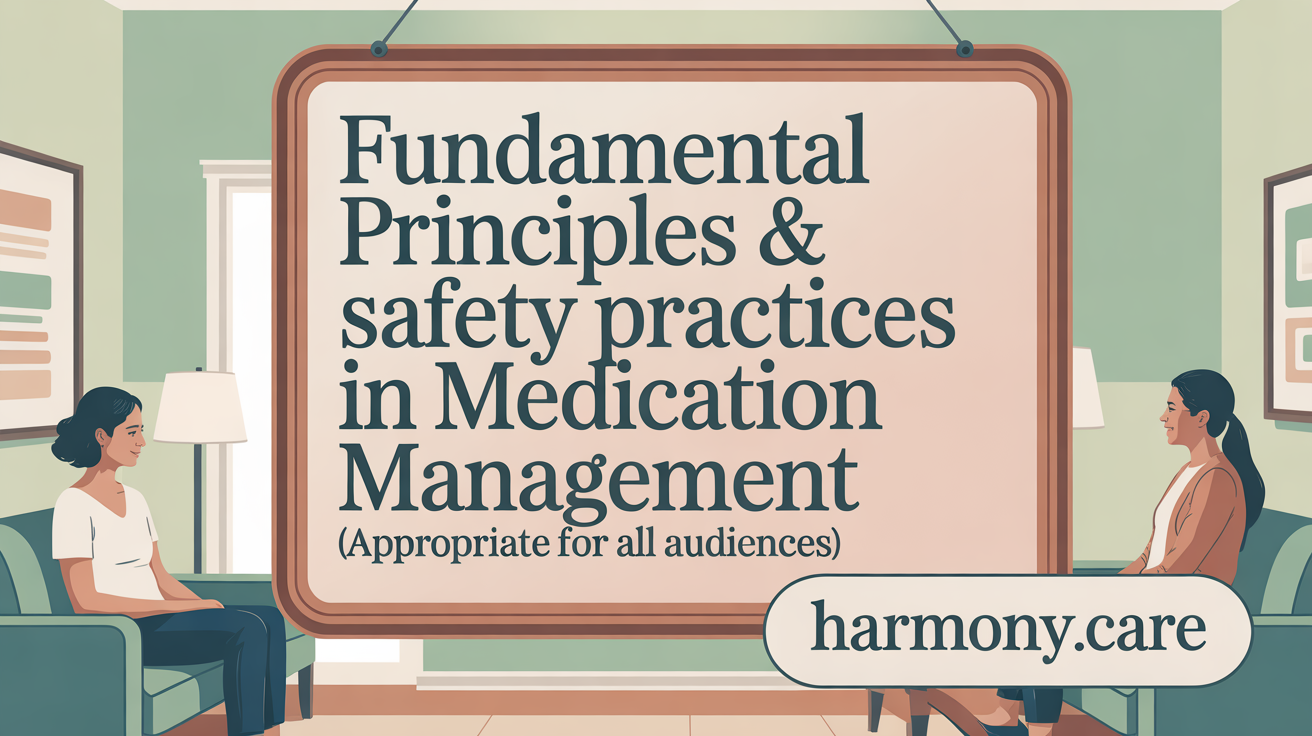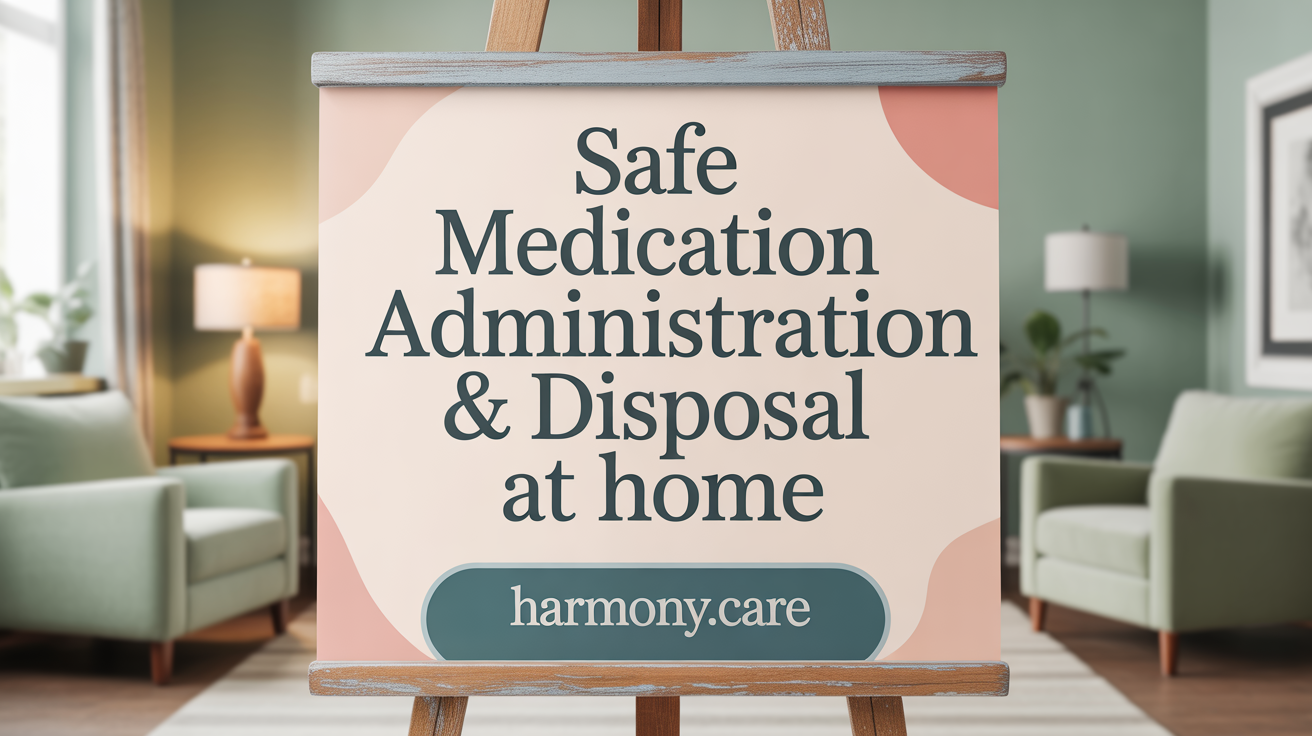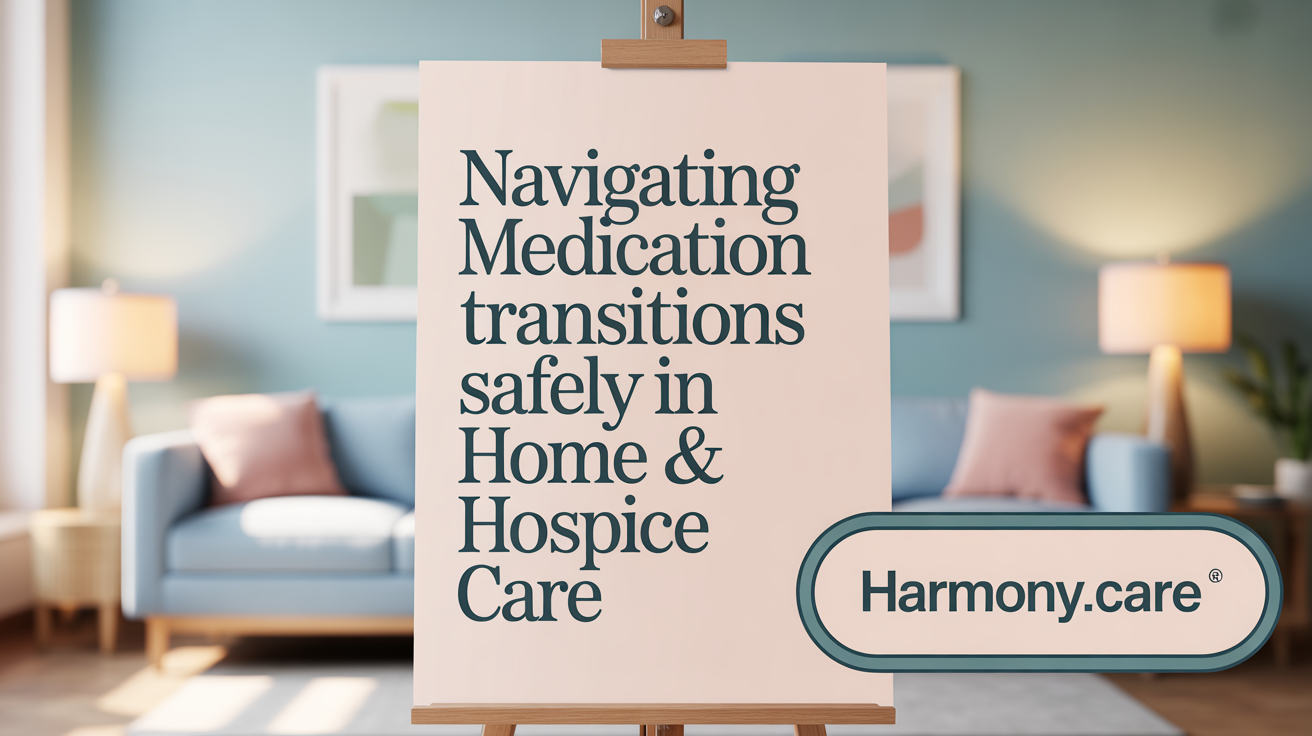The Vital Role of Medication Management at Home
Managing medications effectively in home care settings is critical for patient safety and health outcomes. With many adults taking multiple prescriptions, ensuring the correct use, storage, and disposal of medications can be complex but essential. This article explores best practices, strategies, and technologies that empower patients, caregivers, and healthcare professionals to work together toward safe and effective medication management in the home.
Fundamental Principles and Safety Practices for Medication Management

What are the general principles of medication management?
The basic principles of medication management revolve around safety and effectiveness. Central to this is following the five rights of medication administration: right patient, right drug, right dose, right route, and right time. Healthcare professionals verify medication labels carefully, double-check the intended method of delivery, and measure doses accurately, especially for liquids.
Maintaining clear and detailed documentation, along with scheduling doses and using reminder tools, helps ensure medications are taken correctly and on time. Good communication among patients, caregivers, and providers is essential for reporting issues and preventing errors.
A culture of safety, supported by ongoing staff education, strict protocols, and system-wide safeguards, plays a vital role. Regular training, medication reconciliation, and adherence to established procedures help avoid mistakes, minimize adverse events, and optimize medication efficacy across all settings.
What are basic safety tips for managing medications at home?
Home medication safety begins with proper organization. Use labels and clear lists to keep track of all prescriptions and over-the-counter drugs, noting dosages, timing, and special instructions. Share this list with every healthcare provider involved in your care.
Always check medications before use: verify labels, look for visual confirmation, and confirm expiration dates. Store medicines in a secure, dry, and cool place, out of reach of children and pets. Proper storage preserves medication potency and enhances safety.
Follow prescribed dosages precisely. Use the correct measuring devices for liquids and avoid modifying tablets unless directed by your doctor. Be alert for any side effects, interactions, or changes in medication appearance, and report adverse reactions immediately.
Proper disposal of unused or expired medicines is also crucial. Follow pharmacy guidance or local disposal regulations to prevent misuse or accidental poisoning. Consulting pharmacists for questions about medications can prevent errors and improve overall safety.
What legal and compliance considerations are important in medication management at home?
Legal compliance in home medication management involves adhering to laws related to prescription, storage, and disposal of medicines, particularly controlled substances. Proper documentation of medication regimens, doses, and administration is necessary to ensure accountability and legal responsibility.
Informed consent is fundamental when initiating new treatments or changing medication plans. Secure storage is mandated to prevent unauthorized access, especially for high-risk drugs.
Healthcare providers must develop comprehensive policies on medication protocols, which include medication reconciliation during care transitions and regular review of medication lists. These practices help minimize errors, prevent drug interactions, and ensure patient safety.
Effective communication among patients, caregivers, and professionals, along with staff training and competency assessments, support legal compliance and safety. Regular audits and adherence to regulatory standards help in maintaining high-quality medication management in home care settings.
Enhancing Medication Adherence Through Education, Organization, and Behavior Support

What are effective interventions to improve medication adherence at home?
Improving medication adherence at home involves multiple strategies tailored to individual needs. Personalized education helps patients understand their medication regimen, addresses misconceptions, and identifies barriers. Simplifying dosing schedules, such as using combination pills or coordinated timing with daily routines, reduces complexity. Incorporating technology, like reminder alarms, SMS alerts, electronic medication monitors, or telehealth consultations, supports consistent adherence. Behavioral interventions, including motivational interviewing and cognitive-behavioral techniques, help modify patient behavior and reinforce positive habits. Engaging healthcare professionals such as pharmacists for medication reviews and monitoring side effects enhances adherence. Addressing socioeconomic challenges, like high medication costs, by exploring generic options and financial assistance programs, is also crucial. Implementing these approaches within a multidisciplinary team improves the likelihood of adherence, ultimately leading to better health outcomes and fewer hospitalizations. Combining education, technological support, behavioral strategies, and ongoing professional guidance creates a comprehensive framework for effective home medication management.
How can caregivers and healthcare professionals communicate and educate patients on medication management?
Effective communication is fundamental to safe and proper medication management. Caregivers and healthcare providers should deliver clear, simple instructions tailored to the patient’s literacy and cognitive abilities. Using visual aids, labeled pill organizers, written medication lists, and reminder systems can support understanding and adherence. Educating patients about proper medication storage, administration techniques, and recognizing side effects empowers them to take an active role. Building trust through empathetic dialogue encourages questions and addresses concerns, which improves compliance. Routine medication reconciliation, ongoing monitoring of responses, and adjusting education as needed ensure safety. Technology also offers tools for education, such as apps, telehealth consultations, and digital alerts, providing continuous support. Collaboration among healthcare team members, patients, and caregivers fosters coordinated care, making sure everyone understands the medication plan. This comprehensive approach helps patients feel confident and safe in managing their medications at home, reducing errors and adverse effects.
Organization techniques including pill organizers and reminders
Organizational tools significantly aid in medication adherence. Pill organizers, especially weekly or daily divided compartments, help patients sort medications by dose and time, preventing missed or double doses. Color-coded labels and clear instructions further enhance understanding, especially for patients with visual or cognitive limitations. Reminders such as alarms, smartphone apps, or dedicated medication management devices can prompt timely medication intake. Maintaining an updated medication list—including prescribed drugs, OTC medicines, and supplements—serves as a reference during healthcare visits and supports coordinated care. Combining these techniques—pill organizers, digital reminders, and comprehensive medication lists—creates a reliable system. These organizational methods improve consistency, reduce errors, and foster independence in medication management. Ultimately, effective organization tools empower patients and caregivers to maintain safety and adherence in daily medication routines.
Safe Administration and Disposal of Medications in the Home Setting

What strategies support safe medication administration and disposal in home care?
Ensuring safe medication management at home involves several important strategies. First, healthcare providers and caregivers should strictly follow the 'five rights' of medication safety: right patient, right medication, right route, right time, and right dose. This means verifying the patient's identity with multiple identifiers such as name and date of birth, and double-checking medication labels for correct drug, dosage, and expiration date.
Confirmation of prescriptions with pharmacists or electronic records helps minimize errors. Utilizing tools like barcode scanning and computerized medication administration systems adds a layer of accuracy, reducing mistakes during distribution and administration.
Clear communication with the patient is also essential. Before administering medication, caregivers should explain what the medication is for, how to take it, and what side effects to watch for. After administration, checking in ensures the patient has understood and adhered to the routine.
Proper disposal practices are equally critical. Medications should be discarded following pharmacy or local take-back programs to prevent accidental ingestion, misuse, or environmental contamination. Do not dispose of medicines by flushing unless specifically instructed, and avoid throwing drugs in the trash where they can be accessed by children or pets.
Regular reporting of medication errors, near misses, and adverse reactions is vital for ongoing safety improvement. Healthcare professionals and caregivers must remain vigilant, informed, and proactive to keep medication use safe at home.
How can caregivers and patients work together to ensure medication safety?
Caregivers should be trained on proper storage, administration, and disposal techniques. Maintaining an updated medication list helps track all drugs, dosages, and their purposes, making it easier to identify potential interactions or duplicate medicines.
Patients and caregivers should ask healthcare professionals or pharmacists about uncertainties or side effects. Using pill organizers or reminders such as alarms or apps can support adherence to schedules, reducing missed or double doses.
A team approach, combining professional guidance, patient education, and organizational tools, enhances medication safety in the home environment. Continuous communication and vigilant practices create a safer space for medication use, ultimately protecting health and well-being.
Leveraging Technology to Optimize Medication Management and Safety

How do technological tools improve medication safety and management in home care?
Technology plays a vital role in enhancing medication safety and efficiency for those receiving home care. Electronic medication management systems (EMMS), including electronic health records (EHRs) and e-prescribing platforms, help clinicians and caregivers keep accurate, up-to-date medication lists. These systems reduce errors related to manual data entry and misinterpretation, ensuring that patients receive the correct drugs at the right doses.
Tools like computerized provider order entry (CPOE) help prevent prescribing errors by digitalizing medication orders, which can include built-in alerts for potential drug interactions or allergies, thus supporting safer prescribing practices. Clinical decision support (CDS) systems actively assist healthcare providers during medication decisions by flagging issues such as duplicate therapy or contraindications.
Monitoring technologies such as electronic pill bottles, digital tracking apps, and ingestible sensors further enhance adherence by reminding patients to take medications on schedule and confirming ingestion. For example, ingestible sensors provide direct, real-time data on whether a medication has been ingested, offering highly accurate adherence tracking.
While these innovations significantly reduce medication errors, they are not without challenges. Privacy concerns, data security, and the potential for technological inaccuracies need ongoing management. Nevertheless, integrating AI and machine learning into these systems adds predictive capabilities, enabling early detection and prevention of adverse drug events in home care.
Overall, adopting advanced technological tools supports better communication, adherence, and safety, ultimately improving health outcomes for home-based patients.
Managing Medication Transitions and Overcoming Challenges in Home and Hospice Care

What challenges exist in medication management during home healthcare and how can safety be ensured?
Home healthcare medication management faces several hurdles that can compromise patient safety. Patients with complex medication regimens, such as those on multiple drugs — often called polypharmacy — are particularly vulnerable. Cognitive impairments common in elderly patients, environmental hazards, and caregiver misunderstandings add to the risk.
These challenges can lead to errors like incorrect dosing, missed doses, or accidental overdoses, which may result in adverse health events or hospital admissions. To mitigate these risks, healthcare providers implement thorough medication reconciliation at each transition point, ensuring lists are accurate and complete.
Training staff regularly on medication safety protocols, utilizing electronic health records and reminder devices, and providing clear patient and caregiver education also play crucial roles. Proper medication storage and device maintenance further reduce errors. Promoting open communication among all involved — including patients, caregivers, and healthcare professionals — fosters a culture of safety.
Overall, combining organizational tools, technology, continuous staff education, and proactive communication helps create a safer environment for home medication management, ultimately protecting vulnerable patients from preventable adverse events.
How should medication transitions and changes be managed during home care or hospice services?
Effective management of medication transitions in home or hospice care depends on meticulous coordination. Healthcare teams should conduct comprehensive medication reconciliation—reviewing and comparing current medications with new prescriptions—at every care transition, such as hospital discharge or change in care settings.
Clear and timely communication is vital. Providers need to inform patients and their caregivers about any adjustments, including why changes are made, how to take new medications, and what side effects to watch for. Pharmacists can assist by verifying medication lists and identifying potential drug interactions.
Use of tools such as updated medication lists, reminders, and medication dispensers supports adherence and reduces errors, especially for those with cognitive or physical limitations. Organizing scheduled follow-ups ensures ongoing assessment of the regimen’s effectiveness and safety.
Integrating organizational strategies, fostering teamwork, and emphasizing patient and caregiver education during these transitions help ensure smooth, safe medication changes. This layered approach minimizes discrepancies and enhances symptom management, contributing to improved quality of life in home and hospice settings.
Collaborative and Proactive Approaches Ensure Optimal Medication Outcomes at Home
Effective medication management for home care patients requires a comprehensive approach combining adherence to fundamental safety principles, patient and caregiver education, strategic use of technology, and robust communication among all involved parties. Addressing challenges such as complex medication regimens and transitions with thorough planning, monitoring, and collaboration supports not only patient safety but also improves quality of life. Legal and compliance adherence underpins these efforts, ensuring medication management in the home setting is both safe and effective. Ultimately, empowering patients and caregivers through knowledge, tools, and supportive healthcare relationships creates a foundation for successful medication outcomes in home care environments.
References
- Medication Management and Safety Tips | Johns Hopkins Medicine
- Medication Management Strategy: Intervention - AHRQ
- Mastering Medication Management: Tips for Home Care
- Medication Self-Management for Home Care Users Receiving ...
- 6 Best Practices for Home Health Aides & Medications
- Reducing Medication Management Risks in Home Healthcare
- Medication Management Services | Home Health Care Patients
